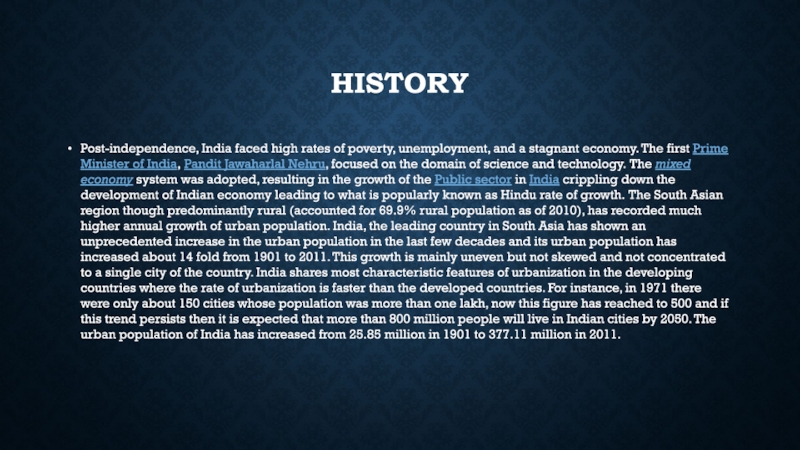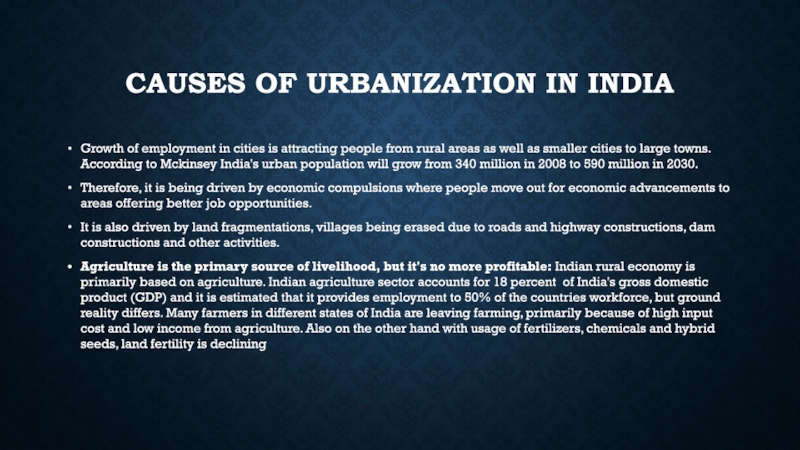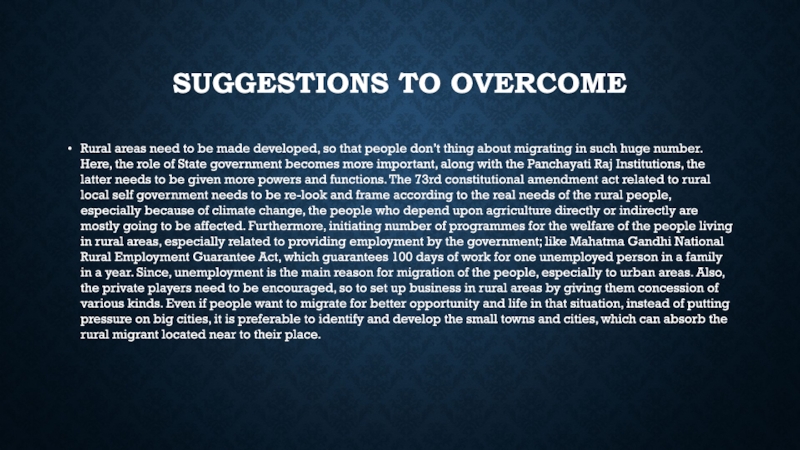Слайд 1Problem of Urbanization in india
created by:-ARPIT KAUSHIK
Submitted to:- SVETLANA SMIROVA
Слайд 2Urbanization in india
began to accelerate after independence, due to the
country's adoption of a mixed economy , which gave rise to the
development of the private sector. Urbanisation is taking place at quite a rapid rate in India. Population residing in urban areas in India, according to 1901 census, was 11.4%. This count increased to 28.53% according to 2001 census, and crossing 30% as per 2011 census, standing at 31.16%. In 2017, the numbers increased to 34%, according to The World Bank. According to a survey by UN State of the World Population report in 2007, by 2030, 40.76% of country's population is expected to reside in urban areas] As per World Bank, India, along with China, Indonesia, Nigeria, and the United States, will lead the world's urban population surge by 2050
Слайд 3HISTORY
Post-independence, India faced high rates of poverty, unemployment, and a
stagnant economy. The first Prime Minister of India, Pandit Jawaharlal Nehru, focused
on the domain of science and technology. The mixed economy system was adopted, resulting in the growth of the Public sector in India crippling down the development of Indian economy leading to what is popularly known as Hindu rate of growth. The South Asian region though predominantly rural (accounted for 69.9% rural population as of 2010), has recorded much higher annual growth of urban population. India, the leading country in South Asia has shown an unprecedented increase in the urban population in the last few decades and its urban population has increased about 14 fold from 1901 to 2011. This growth is mainly uneven but not skewed and not concentrated to a single city of the country. India shares most characteristic features of urbanization in the developing countries where the rate of urbanization is faster than the developed countries. For instance, in 1971 there were only about 150 cities whose population was more than one lakh, now this figure has reached to 500 and if this trend persists then it is expected that more than 800 million people will live in Indian cities by 2050. The urban population of India has increased from 25.85 million in 1901 to 377.11 million in 2011.

Слайд 5Modern india
The contribution of the agricultural sector to the GDP of India started to decline and
the percentage contribution from secondary sector increased. The period after 1941, witnessed
rapid growth of four metropolitan cities in India, which were Kolkata, Delhi, Mumbai, and Chennai.[11] The nation's economy saw a rise due to industrial revolution and the invention of new technologies increased the standard of living of people living in urban areas.[12] The growth of public sector resulted in development of public transport, roads, water supply, electricity, and hence the infrastructure of urban areas. Some of the cities like Three tier also increasing population.
Слайд 6Modern india
Maharastra was the most urbanized state in India till
1991, stood behind Tamil Nadu in 2001 and third after it in
2011, with Kerala being second, with the urban-total state population ratio. However, Maharashtra's urban population of 41 million, far exceeds that of Tamil Nadu which is at 27 million, as per the 2001 census. The spatial distribution of large cities in India is uneven as out of 100 most populous cities in the country more than 50 are confined to only 5 states namely, Uttar Pradesh, Maharashtra, Tamil Nadu, Kerala and Andhra Pradesh. Other than state capitals and major industrial centre, large cities are mainly concentrated in the national capital region (NCR), the western and southern part of India.
Слайд 8Causes of urbanization in india
Expansion in government services, as a
result of the Second World War
Migration of people during the partition of
India
The Industrial Revolution
Eleventh five-year plan that aimed at urbanisation for the economic development of India
Economic opportunities are just one reason people move into cities
Infrastructure facilities in the urban areas
Growth of private sector after 1990 .
Слайд 9Causes of urbanization in india
Growth of employment in cities is
attracting people from rural areas as well as smaller cities
to large towns. According to Mckinsey India's urban population will grow from 340 million in 2008 to 590 million in 2030.
Therefore, it is being driven by economic compulsions where people move out for economic advancements to areas offering better job opportunities.
It is also driven by land fragmentations, villages being erased due to roads and highway constructions, dam constructions and other activities.
Agriculture is the primary source of livelihood, but it's no more profitable: Indian rural economy is primarily based on agriculture. Indian agriculture sector accounts for 18 percent of India's gross domestic product (GDP) and it is estimated that it provides employment to 50% of the countries workforce, but ground reality differs. Many farmers in different states of India are leaving farming, primarily because of high input cost and low income from agriculture. Also on the other hand with usage of fertilizers, chemicals and hybrid seeds, land fertility is declining

Слайд 10Consequences of urbanization in india
Rapid rise in urban population, in
India, is leading to many problems like increasing slums, decrease
in standard of living in urban areas, also causing environmental damage.
The Industrial Revolution of the 18th century caused countries like the United States and the United Kingdom to become superpowers, but conditions elsewhere are worsening. India's urban growth rate is 2.07%; seemingly insignificant compared to Rwanda, with 7.6%. India has around 300 million people living in metropolitan areas. This has greatly increased housing issues: with overcrowded cities, many people are forced to live in unsafe conditions, such as illegal buildings. Water lines, roads and electricity are lacking in quality, resulting in a decline in living standards. It is also contributing to the issues presented by pollution.
Слайд 11Allan Chirare, 15 August 2015 quotes: "Urbanization is just becoming
a disaster to the city of Mumbai in India."
It could
be argued that urbanization impacts the migrants themselves on multiple levels. Networks of friends and family become support systems during the initial transformation phase and the struggle to find work in a fast-paced environment. Their struggles may take months, or even years, to adjust to the new surrounds in order to find a stable job. Migrants are responsible for supporting both themselves in the city and the family left at home.
Some of the positive effects resulting from rural to urban migration occur in the agrarian communities from which migrants came. Family members left at home, usually the elderly and young, are eased out of financial pressures as their relatives work to provide higher standards of living for their dependants. Their quality of life is often additionally improved by the provisions that the migrant sends back.
Слайд 121. National Institution for Transforming India [NITI Ayog], has released
report ‘Composite Water Management Index’ in June 2018 and stated
that 21 cities (including Delhi, Mumbai, and Bangalore) in India would run out of groundwater by 2020.
2. The latest database of Numbeo lists three Indian cities among the top 10 cities of the world for having worst traffic conditions. These cities include Mumbai, Pune and Kolkata.
3. Population growth and rapid urbanization are combining to create huge challenges for Indian cities. According to McKinsey,the country's cities are expected to grow from 340 million people in 2008 to a whopping 590 million in 2030 and this growth will be very rapid. Meeting demand for urban services in these cities will require US$1.1 trillion in capital investment over the next 20 years. Without the right design and planning, this massive urban growth could exacerbate existing problems of congestion, pollution, and traffic safety.
Слайд 13. Delhi is now considered the most polluted city in
the world, according to the Brookings Institution, while at least
two-and-a-half million premature deaths are blamed on poor air quality across the country as a whole.
5. The Economic Survey Report of India 2017-18 estimated that percentage of agricultural workers of total work force would drop to 25.7 per cent by 2050 from 58.2 per cent in 2001. What is the cause of this decline? People migrating to cities and adding to the unemployment in cities. It is interesting to know that because of migration from rural pockets to urban (cities), unemployment in cities is increasing and in rural pockets it's decreasing. As per Centre for Monitoring Indian Economy (CMIE) overall unemployment rate of India as on 18 October 2018 is 6.9% , whereas for urban India its 7.5% and for rural India its 6.6%.
Слайд 18Issues and challenges
As our country moves along on the path
of urbanization, we will find new problems and challenges emerging
out of it, some of which are already felt. While urbanization process resulted into economic growth in our society, but equally it is true that there exist number of problems associated with the urbanization. Some of them are discussed below: The urbanization is also one of the reasons, for the global warming throughout the world and led to climate change even in India, we already seeing the impact of climate change on monsoon pattern and in near future, we will see more in other areas.
Слайд 19Issues and challenges
As the population is increasing, we will see
this problem more, already food inflation in our country is
increasing, and affects the lives of both rural and urban people. But, more on the former category and even in urban areas, it will be more on the poor urban people. Furthermore, it will be increase more, as the contribution of agriculture and its allied activities towards the GDP in recent times is going down. Also, with the increase in urban population, more and more agricultural land or areas need to be converted for constructing houses, bridges, highways for urban use, which will affect agriculture production in near future.
Слайд 20Issues and challenges
The all India HCR [Head Count Ratio] for
below poverty line has declined by 7.3% from 37.2% in
2004-05 to 29.8% in 2009-10. The rural poverty has declined from 41.8% in 200405 to 33.8% in 2009-10, which was a decline of 8% during above period. In the above mentioned same period, the urban poverty has declined from 25.7% to 20.9%, which was decline of 4.8%. If we compare data of both rural and urban areas, it clearly shows that urban areas are lagging, behind in the reduction of poverty rate, even though during the above mentioned period was the most successful period for the Indian economy, which saw huge economic growth. But this doesn’t truly translate in reduction of poverty in urban areas, especially to the urban poor. Also, the poverty ratio among the different social groups in urban areas is high for SC [Scheduled Caste] 34.1% and ST [Scheduled Tribe] 30.4%; whereas for OBC [Other Backward Classes] 24.3% and for all other classes it was low as 20.9% (Press Information Bureau, 2012, March 19). It is interesting fact, which clearly reflects with majority of population, who stays in slums and unauthorized places are SC people and they are mostly poor.
![Problem of Urbanization in india Issues and challengesThe all India HCR [Head Count Ratio] for below Issues and challengesThe all India HCR [Head Count Ratio] for below poverty line has declined by 7.3%](/img/tmb/7/603697/a60ef0b273859adcd70b69226d9a24f1-800x.jpg)
Слайд 21Suggestions to overcome
Rural areas need to be made developed, so
that people don’t thing about migrating in such huge number.
Here, the role of State government becomes more important, along with the Panchayati Raj Institutions, the latter needs to be given more powers and functions. The 73rd constitutional amendment act related to rural local self government needs to be re-look and frame according to the real needs of the rural people, especially because of climate change, the people who depend upon agriculture directly or indirectly are mostly going to be affected. Furthermore, initiating number of programmes for the welfare of the people living in rural areas, especially related to providing employment by the government; like Mahatma Gandhi National Rural Employment Guarantee Act, which guarantees 100 days of work for one unemployed person in a family in a year. Since, unemployment is the main reason for migration of the people, especially to urban areas. Also, the private players need to be encouraged, so to set up business in rural areas by giving them concession of various kinds. Even if people want to migrate for better opportunity and life in that situation, instead of putting pressure on big cities, it is preferable to identify and develop the small towns and cities, which can absorb the rural migrant located near to their place.

Слайд 22The basic infrastructure of urban areas, need to be developed.
For which over the next decade, the investment of rupees
in excess of US Dollar 1 trillion of public investment is needed, according to an estimate of CII [Confederation of Indian Industry] (op.cit., Confederation of Indian Industry, 2010 ). Similarly, other organizations and committees have also estimated, like the Mckinsey which estimates the urban infrastructure expenditure for next 20 years, will be total of $1.20 trillion; out of which the two most important sectors is water infrastructure which needed $200 billion and second one urban transport which needed $590 billion. The Ahluwalia Committee of the Government of India estimates, urban infrastructure expenditure will be total of $785 billion, out of which water infrastructure needed $150 billion and urban transport $460 billion (op.cit., Mohan, 2012 ).
Слайд 23notes
Note 1: Crime Rate means: incidence of crimes
committed against children per one lakh
population of children (up to 18 years of age).
Note 2: Suicide Rate means Number of Suicides per one lakh population.
Note 3: 100 Paisa means One Rupee (Indian Currency)
Слайд 24references
"Urban population (% of total) | Data“
"Urbanization in India faster
than rest of the world“
https://21stcenturychallenges.org/urbanisation-2/